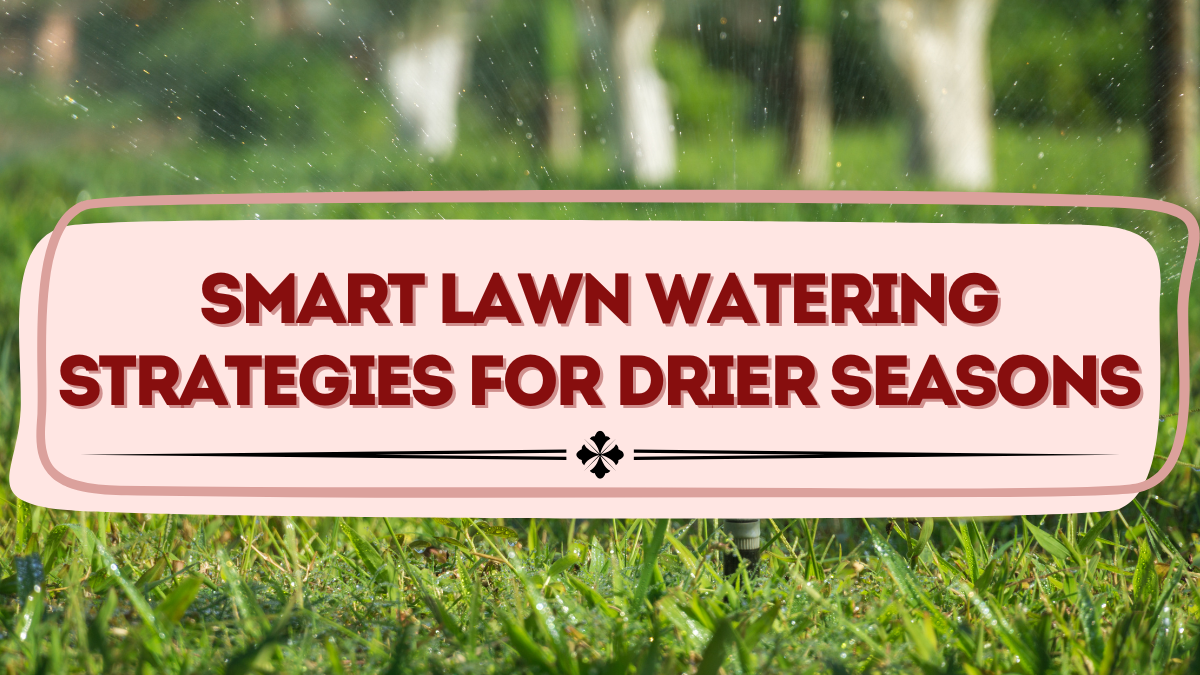Keeping lawns healthy during drier seasons can be tricky. Intense summer heat, rising water bills, and irregular rainfall patterns make it harder to maintain a green and lush yard. Many homeowners fall into the trap of overwatering or underwatering, both of which harm grass health. By following the right lawn watering strategies, you can ensure your turf thrives while reducing water usage. This article explores the best practices for lawn watering, smart irrigation options, and sustainable methods that make your garden greener and more resilient.

Why Lawn Watering Strategies Matter
Water is essential for grass growth, but most lawns receive either too much or too little. Overwatering creates shallow root systems, encourages fungal growth, and wastes water. Underwatering, on the other hand, leads to browning, weak turf, and poor recovery from stress. The ideal approach is to water lawns deeply but infrequently, which trains roots to grow deeper into the soil and improves drought tolerance.
Healthy lawns are not just about appearance. Proper watering helps grass resist pests, diseases, and foot traffic. A well-hydrated lawn also contributes to cooling the environment, reducing dust, and improving air quality. This makes efficient watering practices both an ecological and aesthetic necessity.
Best Practices for Watering Lawns
When it comes to watering, timing and technique make all the difference. Most lawns require 1 to 1.5 inches of water per week, including rainfall. Instead of watering lightly every day, homeowners should aim for fewer but deeper sessions.
Key practices include:
-
Water lawns once or twice a week, deeply soaking the soil.
-
Schedule watering early in the morning, ideally between 5 a.m. and 9 a.m.
-
Avoid nighttime watering to reduce the risk of fungal diseases.
-
Use a rain gauge to measure natural rainfall and adjust irrigation accordingly.
-
Watch for signs of underwatering such as bluish-gray grass blades and lingering footprints.
By sticking to these guidelines, lawns grow deeper roots that access stored soil moisture, keeping grass greener for longer periods without constant watering.
Smart Irrigation Systems
Modern technology has revolutionized lawn care through smart irrigation systems. These systems use soil sensors and weather data to adjust watering schedules automatically. Unlike traditional sprinklers that operate on fixed timers, smart irrigation prevents overwatering by responding to real-time conditions.
For homeowners who want control at their fingertips, many smart irrigation systems come with mobile apps. These apps allow you to monitor soil moisture, rainfall, and adjust schedules remotely. Some municipalities even provide rebates for installing water-saving irrigation systems, making them a cost-effective upgrade.
Here’s a quick comparison of irrigation methods:
| Irrigation Method | Efficiency | Best Use Case |
|---|---|---|
| Traditional Sprinklers | Medium | Large lawns needing broad coverage |
| Drip Irrigation | High | Garden beds, shrubs, and lawn edges |
| Smart Irrigation (Sensor-Based) | Very High | Entire lawns and water conservation |
| Manual Watering | Low | Spot watering small lawn areas |
Choosing Drought Tolerant Lawns
Another way to cut down water use is to select drought tolerant lawns. Grass species like Bermuda, Zoysia, and Buffalo grass naturally require less water while maintaining a lush look. These varieties are bred to withstand long dry spells and recover quickly after rainfall. Mixing clover or native plants with grass is another option, as they add biodiversity and reduce the need for frequent irrigation.
For regions where drought is common, homeowners may even consider lawn alternatives such as tapestry lawns, ornamental grasses, or xeriscaping. These eco-friendly solutions combine low-maintenance with water conservation, offering both beauty and sustainability.
Sustainable Water-Saving Tips
Beyond irrigation, simple changes to lawn care routines can dramatically improve water efficiency.
Effective water-saving tips include:
-
Aerate the soil annually to improve water absorption.
-
Add compost or organic matter to increase soil’s water-holding capacity.
-
Apply mulch around borders and garden beds to retain moisture.
-
Mow grass higher to shade the soil and reduce evaporation.
-
Install rain barrels to collect and reuse natural rainfall.
-
Plant shade trees to cool the lawn and lower water needs.
By integrating these sustainable practices, you reduce water dependency and create a lawn that stays green longer without excessive irrigation.
FAQs
How many times per week should I water my lawn?
Most lawns need one to two deep watering sessions per week, depending on rainfall and temperature.
Is morning or evening watering better?
Morning watering is best because it reduces evaporation and prevents fungal diseases that thrive in wet nighttime conditions.
Which grasses are most drought tolerant?
Popular drought-tolerant grasses include Bermuda, Buffalo, and Zoysia, as they thrive in warm climates and need less water.
Can smart irrigation really save money?
Yes, smart irrigation systems reduce overwatering and can lower water bills by 20–30 percent annually.
How do I check if my lawn is underwatered?
Signs of underwatering include grass turning bluish-gray, soil that feels dry, and footprints that remain visible on the lawn.
Conclusion
The secret to a thriving lawn in dry conditions is not watering more but watering smarter. By adopting deep and infrequent watering patterns, installing smart irrigation systems, and choosing drought tolerant lawns, homeowners can maintain a green, healthy yard while conserving precious water. Combining these strategies with sustainable practices like aeration, mulching, and rainwater collection ensures your lawn not only survives drier seasons but thrives through them. A little planning goes a long way in making your lawn more resilient, eco-friendly, and cost-efficient.
Click here to know more.
